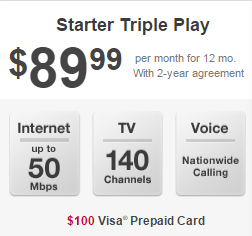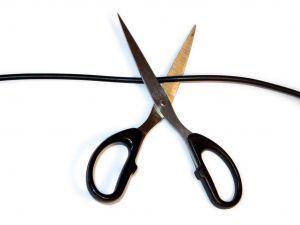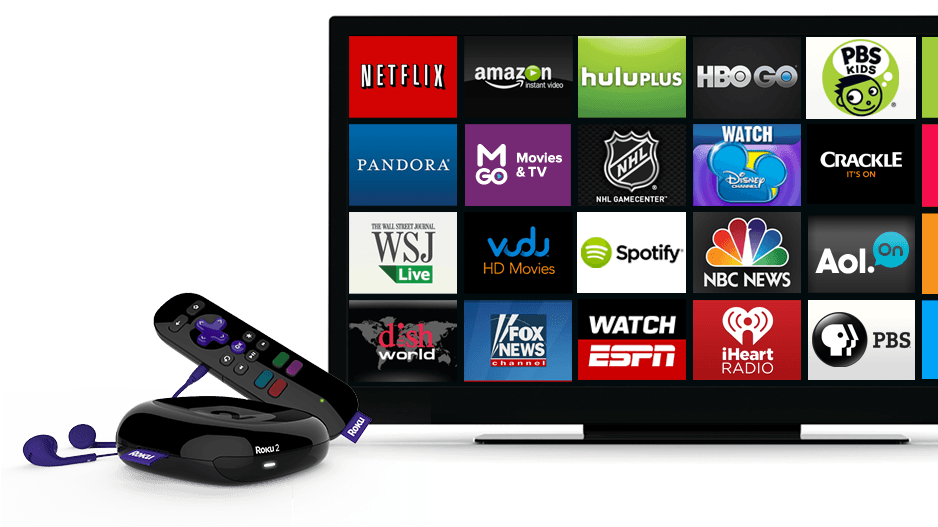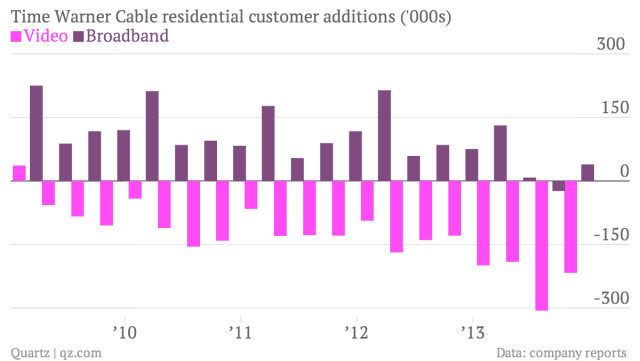
A typical promotional offer from Comcast for a bundle of broadband, TV and phone service.
Cable and phone companies will continue to raise the price of broadband-only service while also increasing the value proposition of bundled packages of broadband, television, and phone service to keep customers from cutting the cable television cord.
For at least four years, cable companies have refocused rate increases and fees on Internet access, especially for broadband-only customers. At the same time, cable-TV rate hikes are easing, especially for customers subscribed to two or more services. Today, customers face prices as high as $67 a month for standalone Internet service. But that price can drop in half if customers bundle broadband with television and phone service. Most triple play promotions in markets where AT&T U-verse and Verizon FiOS compete can be as low as $90 a month. In less competitive markets, a similar promotion often costs $99-119 a month.
Recent research by Sanford Bernstein reveals these pricing strategies are not happening by accident.
Media analyst Todd Juenger recently held his second cord-cutting focus group in Comcast-dominant San Francisco and found some of those most likely to cancel cable television decided to keep their Comcast bundle after they discovered the cable company charges $66.95 a month for Internet-only service, excluding the modem rental fee. For $10 more per month during the first year, customers can get that same 25Mbps broadband service bundled with 140 TV channels. Assuming the customer doesn’t protest the subsequent rate increase beginning a year later, that rate will eventually reset to $136.90 a month. But price-sensitive customers who complain often avoid any rate increase at all.
Juenger’s focus group surveyed 18 men and women in the age group most likely to drop cable television – 21-38 year-olds. Despite their love for Netflix, Hulu, Amazon, and other online video services, the participants broadly recognized the cable/telco bundle now delivers a better value proposition and as long as cable and phone companies continue to price up standalone Internet service, many will choose to stay with the company they hate and not try to cobble together a comparable package of broadband and television service from other providers.
 “Hence, we remain cautiously optimistic that cord-cutting, in large numbers, isn’t likely to happen,” Juenger wrote his clients. “It’s one of those ideas that sounds great in the abstract but crumbles when faced with the reality.”
“Hence, we remain cautiously optimistic that cord-cutting, in large numbers, isn’t likely to happen,” Juenger wrote his clients. “It’s one of those ideas that sounds great in the abstract but crumbles when faced with the reality.”
As cable television pricing continues to exceed many household budgets, providers are seeking new customers that can afford cable TV but choose not to subscribe. One of their primary targets: broadband-only customers and cord-nevers who might be persuaded to add cable television at a starting price of $10-20 above what they pay for broadband service. That price is less than what Sling TV or PlayStation Vue charges for far fewer channels.
The challenge competing online video providers face is finding a compelling limited channel lineup that will appeal to all-comers. Although the average cable subscriber generally watches fewer than a dozen cable channels regularly, not having access to one or more of those favored channels is a deal-breaker for many.
Juenger’s focus group was most open to a hypothetical a-la-carte package of any 10 customer-chosen channels for $20 a month. But Juenger reminded his investor clients no such package currently exists and probably never will.
“Simply put, for existing pay-tv subs, the content [available to Sling or View customers] is too limited (relative to the cost savings); and for cord-nevers, the price is too high (relative to the appeal of the content),” Juenger wrote.
But Juenger did warn that customers are enthusiastic about sticking it to their current provider, if they can get the programming they want. That could make some programmers, especially broadcast stations and networks, more vulnerable to revenue loss. If a company can reliably offer a variety of theme-based slimmed down cable packages coupled with an effective and seamless over-the-air antenna, no retransmission fees would be paid to over-the-air stations and networks.
If the bundled package pricing argument doesn’t work with cord-cutters, the broadband usage cap probably will. Customers will quickly learn they can eat through their monthly Internet usage allowance watching live television online, or avoid that prospect by subscribing to cable TV, which offers unlimited viewing.


 Subscribe
Subscribe
 “I think its to early to say how its going to impact the traditional world,” Williamson said in response to a question about whether Boxless Homes will replace traditional MPEG-2 services or augment them. “Currently we don’t even market it or tell anyone about it. The IP video stuff has rolled out word of month. These are the early adopters who are understanding that there’s a TWC app that goes on the Roku box. They decide to go down to their kid’s room or somewhere else and make that their secondary outlet. That’s how it’s evolving now. I think as it gets more and more prevalent and we get on more and more devices, which is going to take time, then its going to be more interesting. Our app on Samsung TV is much closer to our same look and feel as on our se-sop box. Unfortunately these are the real high-end Samsung TVs with the smart hub technology and things like that. There’s not enough of them to understand what the impact is on our footprint.”
“I think its to early to say how its going to impact the traditional world,” Williamson said in response to a question about whether Boxless Homes will replace traditional MPEG-2 services or augment them. “Currently we don’t even market it or tell anyone about it. The IP video stuff has rolled out word of month. These are the early adopters who are understanding that there’s a TWC app that goes on the Roku box. They decide to go down to their kid’s room or somewhere else and make that their secondary outlet. That’s how it’s evolving now. I think as it gets more and more prevalent and we get on more and more devices, which is going to take time, then its going to be more interesting. Our app on Samsung TV is much closer to our same look and feel as on our se-sop box. Unfortunately these are the real high-end Samsung TVs with the smart hub technology and things like that. There’s not enough of them to understand what the impact is on our footprint.”

 Cable ONE customers nationwide lost eight Turner Networks channels yesterday, despite the fact the cable company has a signed contract with Turner to pay for some of the networks that have gone dark.
Cable ONE customers nationwide lost eight Turner Networks channels yesterday, despite the fact the cable company has a signed contract with Turner to pay for some of the networks that have gone dark. “We signed contracts for TBS, TNT and the Cartoon Network through the National Cable Television Cooperative (NCTC), which allows for the purchase of individual channels rather than the entire bundle of eight,” said Might. “In a disgraceful punitive reaction, Turner Networks refused to recognize the NCTC contracts and immediately de-authorized all Cable ONE systems in order to ‘teach’ Cable ONE a lesson about the power of cable programmers to tie and bundle channels together and force carriage of unwanted bundles. They refuse to give cable operators or their customers any choice about what they can or cannot buy.”
“We signed contracts for TBS, TNT and the Cartoon Network through the National Cable Television Cooperative (NCTC), which allows for the purchase of individual channels rather than the entire bundle of eight,” said Might. “In a disgraceful punitive reaction, Turner Networks refused to recognize the NCTC contracts and immediately de-authorized all Cable ONE systems in order to ‘teach’ Cable ONE a lesson about the power of cable programmers to tie and bundle channels together and force carriage of unwanted bundles. They refuse to give cable operators or their customers any choice about what they can or cannot buy.”